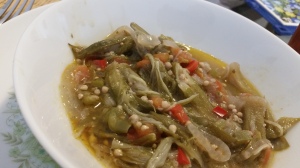It was another summer Friday in the neighborhood and that called for another festive cocktail. Riding high on the success of last session’s passionfruit mojitos, I decided to make mango mojitos. The drink itself followed much the same construction, but the mango was decidedly sweeter than the passionfruit, so I decided that it needed a spike of heat and salt for proper balance.
Ancho chile salt on the rim provided just the right touch.Your lips get hot, your tongue gets salty, then the potent sweetness of the mango and rum drenches your mouth in happiness!
I made enough to take to a Spuyten Duyvil concert at the farm two days later. Once again, big hit (except for the bit about the plastic cups…it is not good form to use one-time use cups in our world, but sometimes it happens; mea culpa)!
Mango Mojitos with Ancho Chile
3 parts rum
2-3 parts mango nectar or juice
1 part simple syrup (1 part sugar, 1 part water heated until clear and liquid and cooled)
Ancho chile salt
1 Tbs ancho chile powder
1 Tbs table salt or salt crystals
Limes quartered
Mint leaves
Ice
Club soda or seltzer
Mix rum, juice and syrup together and place in a container until you are ready to use.
Mix salt and ancho chile powder thoroughly and pour onto a small plate. Rub the rim of your empty glass with lime then twirl the rim in the salt until coated.
Add two or three lime quarters, three leaves mint and muddle thoroughly so you have lime juice in the glass. Add ice, pour the mango mix in and top with a bit of club soda or seltzer.












































